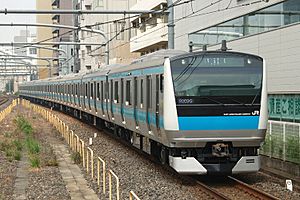Keihin-Tōhoku Line facts for kids
Quick facts for kids Keihin-Tōhoku Line |
|
|---|---|

A Keihin-Tohoku Line E233 series EMU at Saitama-Shintoshin Station
|
|
| Overview | |
| Locale | Tokyo, Saitama, Kanagawa prefectures |
| Stations | 35 |
| Service | |
| Type | Heavy rail |
| Operator(s) | JR East |
| Depot(s) | Saitama |
| Rolling stock | E233-1000 series |
| Daily ridership | 2,974,504 (daily 2015) |
| History | |
| Opened | 1914 |
| Technical | |
| Line length | 59.1 km (36.7 mi) |
| Track gauge | 1,067 mm (3 ft 6 in) |
| Electrification | 1,500 V DC overhead catenary |
| Operating speed | 90 km/h (55 mph) |
The Keihin-Tōhoku Line is a busy railway line in Japan. It connects several big cities like Saitama, Kawaguchi, Tokyo, Kawasaki, and Yokohama. This line is an important part of the East Japan Railway Company (JR East) network.
The Keihin-Tōhoku Line uses parts of the Tōhoku Main Line and Tōkaidō Main Line. However, between Ueno and Akabane stations, the Keihin-Tōhoku and Tōhoku Main lines run on separate tracks. This means they are different routes in that area.
Connecting Cities and Lines
Most trains on the Keihin-Tōhoku Line continue their journey onto the Negishi Line. This through service runs between Yokohama and Ōfuna stations. Because of this, the entire route from Ōmiya to Ōfuna is often called the Negishi Line on maps.
You can easily spot Keihin-Tōhoku Line trains by their bright light blue stripe. This color is also used for the line on railway maps.
Trains on the Line
Since January 2010, all trains on the Keihin-Tōhoku Line are E233-1000 series models. These are 10-car electric multiple unit (EMU) trains. An EMU is a train made of several cars that can all move on their own.
These modern E233-1000 series trains started being used in December 2007. They completely replaced the older 209 series 10-car trains by January 24, 2010. All the trains for the Keihin-Tōhoku Line are kept at the Urawa Depot.
Sometimes, you might also see Yokohama Line E233-6000 series trains on this line. These 8-car trains run through services between Higashi-Kanagawa and Ofuna stations.
Images for kids
-
Morning peak on the Keihin-Tohoku and Yamanote Lines at Ueno Station
See also
 In Spanish: Línea Keihin-Tōhoku para niños
In Spanish: Línea Keihin-Tōhoku para niños











